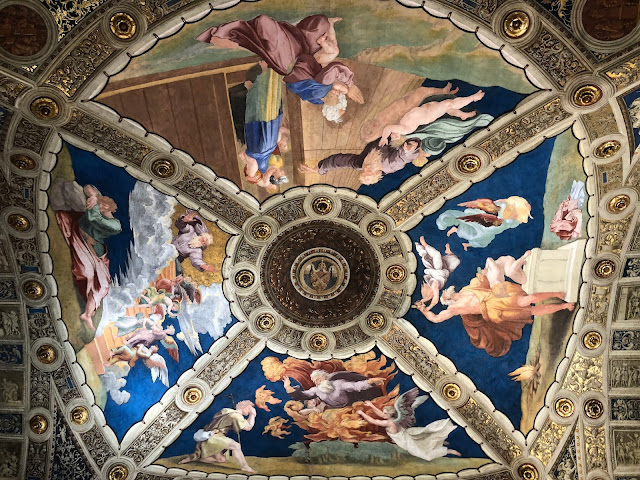【ローマ】ヴァチカン ヘリオドロスの間 Roma - Musei Vaticani, Stanze di Eliodoro
署名の間に続いて、ラファエロはその隣のヘリオドロスの間のフレスコ画を描いた。
この部屋は、教皇が外国からの施設などを迎える際に使われた。
署名の間のフレスコ画が、真・善・美という抽象的なテーマを表現しただったのに対して、このヘリオドロスの間のフレスコ画には、聖書の中に書かれている具体的なエピソードが描かれている。
Following the signature, Raphael painted a fresco between the Heliodros next to it.
This room was used by the Pope to welcome foreign facilities.
Whereas the frescoes between the signatures expressed the abstract theme of truth, goodness, and beauty, the frescoes during the Heliodros have specific episodes in the Bible. Is drawn.
エルサレムの神殿に収められている財宝を盗もうとして侵入したヘリオドロスだが、最後は神から使わされた天使たちによって罰せられて、追放されてしまう、というストーリーが展開されている。
追放される場面では、背景の神殿の建物の描き方が、『アテネの聖堂』によく似ている。
右端には、天使や戦士たちによって追放されるヘリオドロスたちが、リアルな表情によって表現されている。
絵の中央で神に祈りを捧げている大祭司オニアスは、ラファエロに制作を命じたユニウス2世がモデルだ。
Heliodros invades to steal the treasures contained in the temple in Jerusalem, but the story unfolds that he is finally punished and banished by the angels used by God.
In the exiled scene, the way the temple building in the background is drawn is very similar to the "Basilica of Athens".
On the far right, the Heliodros exiled by angels and warriors are represented with realistic expressions.
Onias, the high priest praying to God in the center of the painting, is modeled on Unius II, who ordered Raphael to produce it.
『使徒列伝』には、聖ペテロがエルサレムで牢獄に囚われているときに、天使が彼を牢獄から解放する夢を見た、ということが書かれている。
ラファエロは、そのエピソードを光と闇を使った劇的な表現で再現した。
中心では、天使が牢獄の中から聖ペテロを救おうとしているシーンが、そして右側には2人がすでに牢獄から逃げ出していて、左側ではそれに気づいた兵士たちが慌てて探そうとしている。
The Apostle Retsuden states that while St. Peter was in prison in Jerusalem, an angel dreamed of releasing him from prison.
Raphael recreated the episode in a dramatic way using light and darkness.
In the center, there is a scene where an angel is trying to save St. Peter from the prison, and on the right side, two people have already escaped from the prison, and on the left side, soldiers who noticed it are rushing to find it.
『ボルセーナのミサ』には、13世紀にポーランドで行なった奇跡が描かれている。
ホスチアから血が流れ出すという奇跡を目の当たりした司祭の向かいには、この奇跡を元にできた祝日を深く信奉していたという、ユリウス2世の姿が描かれている。
左下で、こちらをあどけない表情で見つめている幼い子供の姿には、聖母子像の画家としてのラファエロの一面を表している。
The Mass at Bolsena depicts a miracle performed in Poland in the 13th century.
Opposite the priest who witnessed the miracle of blood flowing from Hostia, Julius II is depicted as a deep believer in the holidays based on this miracle.
In the lower left, the figure of a young child staring at us with an innocent look shows one side of Raphael as a painter of the Madonna and Child.
『大教皇レオとアッティラの会談』は、ラファエロとその弟子が描いたということになっている。
そう言われてみると、これまで見てきたフレスコ画よりは、全体的に躍動感にかけた、おとなしい印象に見えてくる。
フン族の王だったアッティラは、強大な勢力を率いて西ローマ帝国に侵攻したが、教皇レオ1世から説得されて撤退した。
実際の会見が行われたのはイタリアの北部だったが、背景にはローマの風景が描かれている。
この絵が描かれた時、すでにユリウス2世はなくなり、次のレオ10世が教皇になっていた。
アッティラを説得するレオ1世は、そのレオ10世の姿で描かれている。
このヘリオドロスの間に描かれているのは、どれも神の力のよってキリスト教の社会が守られたというエピソードばかり。
この部屋で外国の使節と会見した教皇は、これらの絵画を通じて、自分たちは神に守られていることを無言でアピールした。
ラファエロがこの部屋に描いたフレスコ画は、多分に政治的な意味合いを帯びていた。
The "Parley of Pope Leo and Attila" is supposed to have been drawn by Raphael and his disciples.
When you say that, it looks more dynamic and quieter than the frescoes you've seen so far.
Attila, the king of the Huns, led a mighty force to invade the Western Roman Empire, but withdrew after being persuaded by Pope Leo I.
The actual press conference was held in northern Italy, but in the background is a Roman landscape.
By the time this painting was drawn, Pope Julius II had disappeared and the next Pope Leo X had become Pope.
Leo I, who persuades Attila, is depicted in the form of Leo X.
All that is depicted during this Heliodros is an episode in which the Christian society was protected by the power of God.
Through these paintings, the Pope, who met with a foreign envoy in this room, silently appealed that they were protected by God.
The frescoes Raphael painted in this room probably had political implications.







コメント
コメントを投稿